Author: Raserei Source: cointelegraph Translation: Shan Ouba, Golden Finance
The history of Ethereum began more than a decade ago, starting with a gleam in the eye of its founder, Vitalik Buterin, a lanky math genius who was frustrated by the limitations of Bitcoin and believed he could do better with blockchain.
Buterin envisioned that cryptocurrency would no longer be just a monetary asset, but rather expand blockchain technology into a "global computer" - a platform that hosts decentralized applications, driven by smart contracts, with little human intervention or trust assumptions.
Today, Ethereum has become the world's second-largest crypto asset, supporting a multi-trillion-dollar ecosystem of dependent networks. It is the blockchain of choice for several of the world's largest asset managers, as well as for hundreds of thousands of daily users (first layer) and millions of connected second-layer users (second layer).
Here are 11 of the most important moments in Ethereum’s history and some of the major upgrades to look forward to.
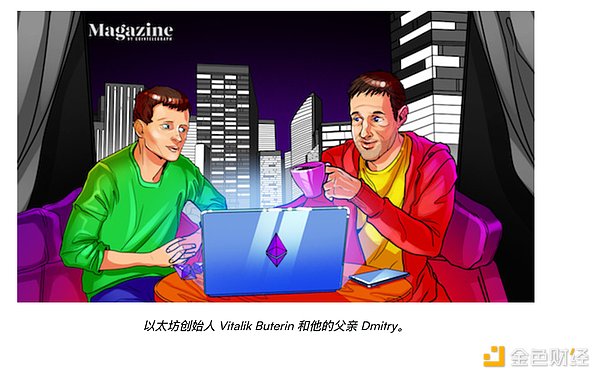
Ethereum White Paper – 2013
Buterin first encountered Bitcoin as a teenager through his father, a Russian-born engineer who immigrated to Canada with his family.
Lacking the funds to invest in Bitcoin mining or the Bitcoin asset itself, Buterin worked as a crypto blogger in the early 2010s and was paid in BTC.
Romanian Bitcoin enthusiast Mihai Alisie noticed his talents as a leading thinker and writer in the field, approached him, and the two founded Bitcoin Magazine in 2012.
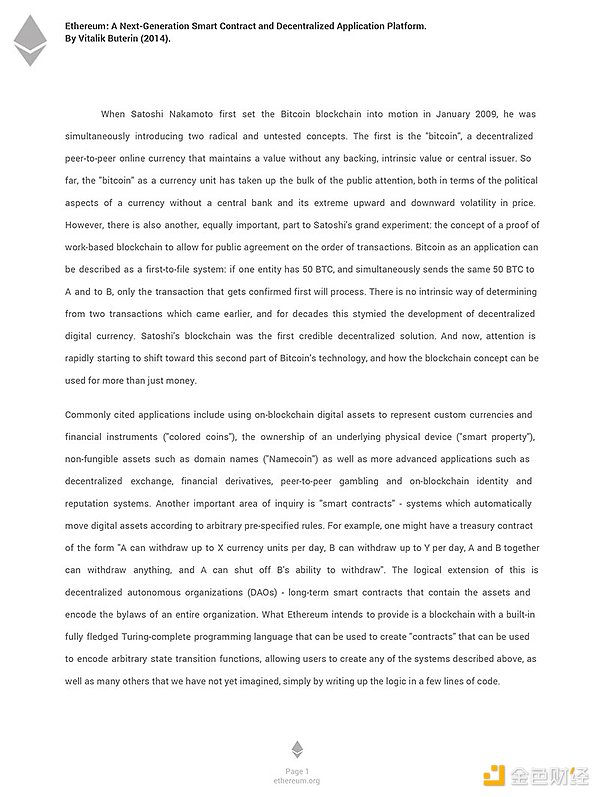
A year later, in 2013, Buterin, then just 19, published the Ethereum white paper, outlining a "next generation smart contract and decentralized application platform." He told Business Insider that the goal was simply to fix the problem of Bitcoin being "too limited in functionality":
Think about the difference between a pocket calculator and a smartphone. A pocket calculator can do one thing, and it does it well, but people actually want to do all these other things. If you have a smartphone, then on your smartphone you have a pocket calculator app. You can play music as an app. You have a web browser as an app, and pretty much everything else. ”
He later received a $100,000 Peter Thiel Fellowship to start working on the Ethereum platform.
Red Wedding – 2014
Before Ethereum became what it is today, it went through some growing pains and conflicts, the first major conflict being the infamous “Red Wedding” – where the future of the network was handed over to Buterin.
As Camila Russo documents in her book The Infinite Machine, on June 7, 2014, the team of co-founders gathered in Zug, Switzerland to sign a document turning Ethereum into a for-profit company.
But the contract was never signed, and there were disputes over Charles Hoskinson’s management style, Amir Chetrit’s Tensions over contributions to the project and Ethereum’s future direction reached a boiling point.
The power over which direction Ethereum should go was left to Buterin, who ousted Hoskinson (who went on to found Cardano) and Chetrit and established Ethereum as a nonprofit foundation rather than a company.
“We had differences of opinion, and sometimes those differences of opinion boiled over to the point where they became known…even notorious,” Ethereum co-founder Joe Lubin told The Journal in a 2023 interview. ”
ICO and Launch – 2014
Ethereum’s next big move was to raise funds and gain widespread public attention during its 2014 Initial Coin Offering, selling millions of dollars worth of ETH to fund the project’s development. Between July 22 and September 2, 2014, ICO investors snapped up over $18 million worth of ETH, paid for with BTC. The Ethereum blockchain and its native token, ETH, officially launched on July 30, 2015. With a market value of $0.31 per ETH token, this marks an impressive 30% increase for anyone lucky enough to hold onto ETH until today’s price of $3,275. 1,057,000% return.
Of course, no one knows for sure, but Ethereum and Consensys co-founder Joe Lubin is rumored to have invested more in ICOs than anyone else.
DAO Hack and Ethereum Classic – 2016
Arguably the most influential event in Ethereum’s history was the now-infamous DAO hack, which saw hackers steal over 3.6 million ETH from the early idealistic decentralized autonomous organization.
The attack sent shockwaves through the market, causing the price of ETH to plummet from $20 to $9 in less than 36 hours.
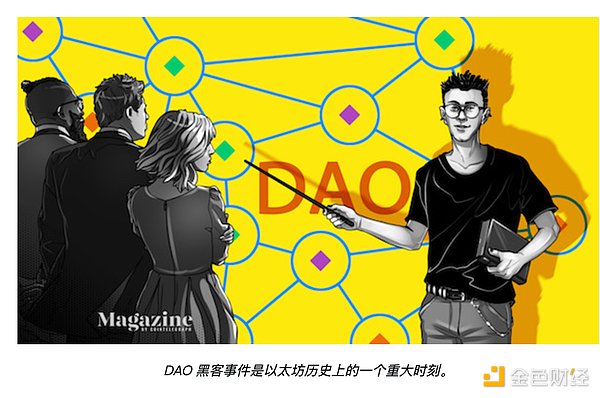
It was a philosophical disagreement: should blockchains be immutable records, with code as law, or can blockchain leaders simply change history to erase inconvenient events? The debate was fierce, and the debate over whether Ethereum was on the right path continues to this day.
Eventually, a majority of the Ethereum community voted to hard fork the network in order to roll back the blockchain and regain the assets lost in the breach.
One of the hard forks was a proof-of-stake blockchain that still retains the Ethereum name to this day, while the other hard fork is known as Ethereum Classic — technically the original version of the Ethereum blockchain, which is still a proof-of-work blockchain.
CryptoKitties Hacked Ethereum — 2017
One of the strangest things to happen on Ethereum was the advent of CryptoKitties, a collection of non-fungible tokens, which more or less broke the entire network.
Launched in October 2017 by Vancouver-based startup studio Axiom Zen, CryptoKitties was intended as a serious and playful experiment in blockchain technology, allowing users to collect and cultivate different types of NFTs.
By early December, CryptoKitties had become all the rage, with NFT prices reaching as high as $170,000. Kitties demand and activity was so high that it clogged the Ethereum network, causing fees to soar.
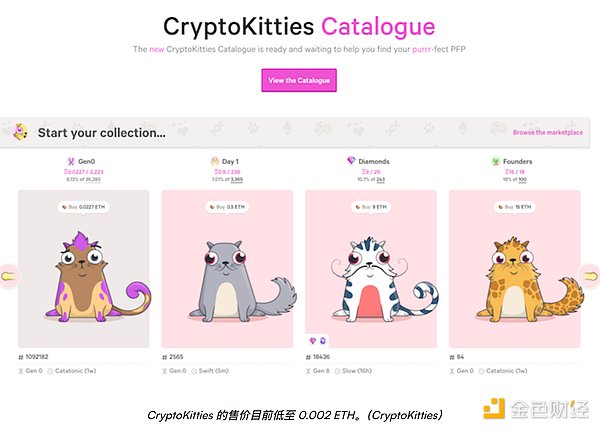
In response to the sudden network outage, an elite team of Ethereum developers from projects like MetaMask and Infura banded together to deploy rapid optimizations and work on long-term scaling solutions for the network.
While crypto enthusiasts remain divided over the quality and value of the CryptoKitties project itself, it is undeniable that it had a huge impact on the development of the Ethereum network and helped to spark the NFT craze.
The Summer of DeFi — 2020
The summer of 2020 — colloquially known to crypto enthusiasts as the “Summer of DeFi” — marked a turning point in crypto history, with Ethereum suddenly becoming a hotbed for entirely new financial activity.
New users flocked to the Ethereum network, all eager to try out the hundreds of new protocols that had sprung up on the network. This sparked a boom in digital asset lending and trading across hundreds of protocols, many of which now form the backbone of today’s multi-billion dollar DeFi industry. Much of the activity was driven by “yield farmers,” who were rewarded with tokens for their activity. This was either a genius way to kickstart a flywheel, or an unsustainable Ponzi economics.
The well-known Ethereum-based DeFi protocols that emerged during the DeFi summer, including Aave and Compound, now have a total locked value of tens of billions of dollars and daily trading volume of hundreds of millions of dollars.
Food-themed DeFi has also seen explosive growth, most notably SushiSwap, which forked Uniswap and performed a "vampire attack" on it to gain liquidity and users. After Chef Nomi cashed out $14 million in SUSHI, he handed control of the DEX to a young upstart investor named Sam Bankman-Fried.
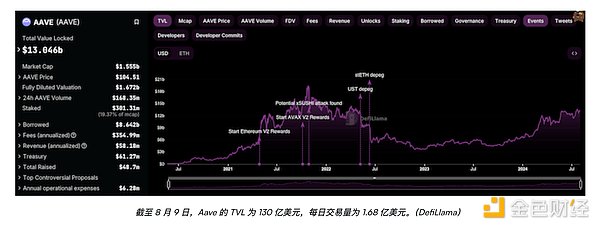
Rollup Roadmap Reorganization - October 2020
According to Ethereum developer Marius van der Wijden, one of the biggest advantages of Ethereum is that its roadmap itself is not very strict or fixed.
He told the magazine that the community is constantly "debating what to do next and what to prioritize," which is crucial to keeping Ethereum decentralized and avoiding capture.
This flexibility was on display in October 2020, when Buterin abandoned his long-standing Eth 2.0 roadmap, which planned to scale Ethereum in a monolithic fashion using OG sharding — which looked more like 64 Ethereum blockchains running in sync together.
But Buterin abandoned this form of sharding (later implemented by projects like Near) as alternative solutions began to emerge in the form of optimism and ZK-rollups, layer 2 projects that separate execution and computation from the main chain but still inherit its security.
Since research and development showed that this would be a viable path to scaling, he released a new “rollup-centric roadmap.”
The new Rollup roadmap ensures that the Ethereum network will become the best base layer blockchain, with most of the expansion and experimentation taking place through Layer 2 networks such as Polygon, Optimism, and Arbitrum. Optimistic Rollup is seen as a faster solution to implement, while ZK Rollup is seen as a possible final solution. “Today, they’re leveraging a lot of technical discoveries that we have now that didn’t exist 10 years ago. So, for example, data availability sampling… didn’t exist before 2017 — 2017 is when I published my first work on it. Optimistic and ZK-rollups didn’t actually exist before about 2019,” Buterin said at the ETH Seoul 2022 press conference.
Proof-of-Stake, Merger — September 2022
Van der Wijden said he considered the merge to be the “most pivotal” moment in the Ethereum network’s history.
The merge, which was completed on September 15, 2022, marked the transition from the energy-intensive proof-of-work consensus mechanism to the more environmentally friendly proof-of-stake mechanism.
“This was a huge effort with many people working together for a common goal — I’m glad we did it. After reading some of the numbers about electricity, CO2 consumption, and e-waste, I’m proud to be part of this effort.”
The merge reduced Ethereum’s energy consumption by 99% and brought about a major shift in the network’s token economics.
Dencun Upgrade: Blobs and Sharding — March 2024
The next critical step for Ethereum occurred on March 13, 2024, when the Dencun upgrade was implemented on the network.
The Dencun upgrade introduced a suite of nine different Ethereum Improvement Proposals (EIPs), the most notable of which was EIP-4844.
EIP-4844 introduced proto-danksharding, which significantly reduced the fees paid for block data on the Ethereum layer 2 network by leveraging “blobs,” a mechanism that allows for separate and temporary storage of transaction data.
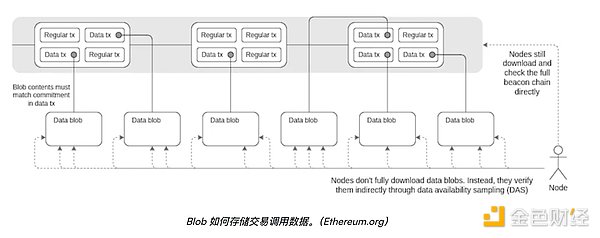
Dencun has seen a significant reduction in the cost of executing transactions on Ethereum layer 2 networks such as Arbitrum and Optimism; however, a side effect is that the total amount of ETH fees destroyed on the mainnet has also dropped significantly.
eOracle contributor Matan Si told the magazine that the most important development on Ethereum since the merger has been the expansion of rollups and layer 2 solutions.
What excites me most about the future of Ethereum is its potential to bridge the gap between these execution layers and the real world. Connecting on-chain activity with off-chain data and computation will unlock countless new use cases. ”
BlackRock Chooses Ethereum – March 2024
One of Ethereum’s biggest institutional milestones occurred on March 20, when asset management giant BlackRock launched its tokenized fund on the Ethereum network.
The money market fund, called the BlackRock USD Institutional Digital Liquidity Fund, or BUIDL, is fully backed by cash and U.S. Treasuries and offers investors a daily yield paid to token holders.
The move was widely seen as a big endorsement of the Ethereum network’s reliability and trustworthiness by the world’s largest asset manager.
According to rwa.xyz, the BUIDL fund currently has a market cap of $517 million and saw over $116 million in trading volume last month.
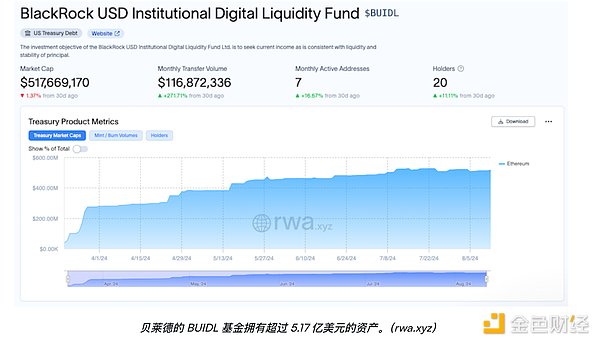
BlackRock CEO Larry Fink said that while he was initially a "naysayer" of crypto assets, he has changed his mind and sees cryptocurrencies, especially Ethereum and Bitcoin, as an emerging asset class. Fink told CNBC on January 12: "I've been a big believer in ETH over the past two years. ”
Spot ETF Launches – July 2024
Nine spot Ethereum ETFs were first approved by the U.S. Securities and Exchange Commission (SEC) on May 23 and officially launched on July 23. The launch of the spot funds marks an important step for ETH as an institutional-grade asset.
Like the Bitcoin ETF, the Grayscale Fund’s launch also suffered a slump as investors sold their holdings in Grayscale funds, and its converted Grayscale Ethereum Trust (ETHE) has 10 times higher fees than other ETFs.
As of press time, these funds have seen net outflows of $390 million; however, ETHE The flow of money is slowing, and Nate Geraci, president of the ETF Store, said that three weeks of inflows into BlackRock’s ETHA already makes it the sixth most successful ETF launched this year.
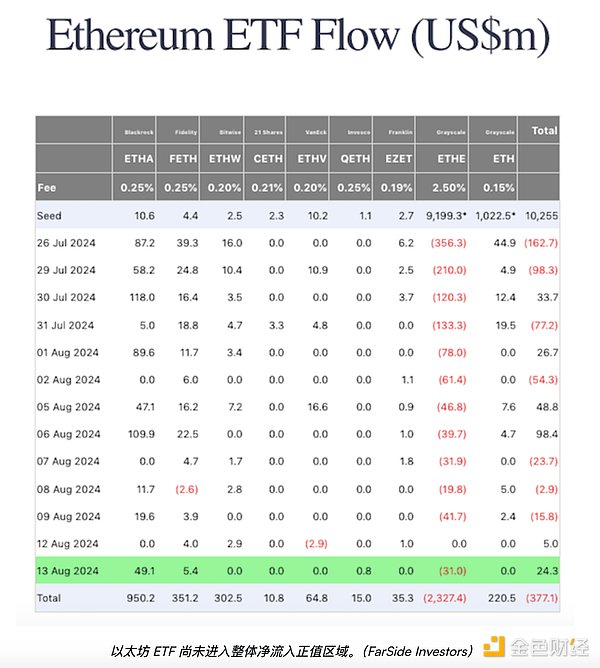
Next Steps: Pectra, Verge, and Splurge
The next big step on the roadmap is the Pectra upgrade, which van der Wijden said will encompass “a series of upgrades” to the ethereum virtual machine, enabling new use cases, such as trustless staking pools, and making life easier for developers.
After Pectra Vitalik then launched Verkle, or Verge.
“With Verkle, we changed the way we store state — all accounts, balances, contracts — to make it easier to prove that your balance was x at block y,” van der Wijden said.
Van der Wijden describes the “cleanse” as a series of new upgrades designed to get rid of old features that are no longer useful to the network.
“When Ethereum started, they made a lot of assumptions about how things would work, and a lot of them turned out to be correct, but some didn’t work out the way they expected,” van der Wijden explained.
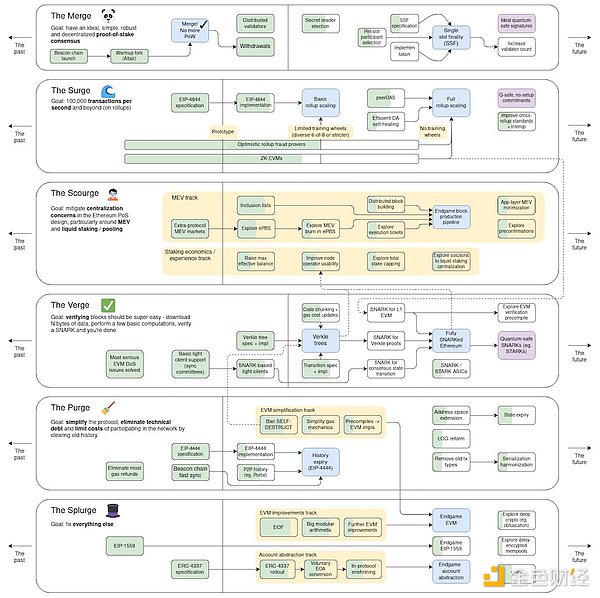
The latest version of the Ethereum roadmap. (Vitalik Buterin/X)
“So we will slowly clean up some of the paths not taken, like disabling Selfdestruct (which was done with the last upgrade) or getting rid of bloom filters in receipts in the future (which will make syncing nodes faster),” he added.
Splurge is also self-explanatory, at least at a top-line level, with new features that the Ethereum community is willing to “splurge” on.
“They include some of the changes already mentioned to make ethereum easier to use. If we feel there is enough room (in terms of complexity) for the upcoming hard fork, these changes may be released together with other upgrades,” van der Wijden said.
 JinseFinance
JinseFinance
 JinseFinance
JinseFinance Weiliang
Weiliang JinseFinance
JinseFinance Coinlive
Coinlive  Others
Others Numen Cyber Labs
Numen Cyber Labs Bitcoinist
Bitcoinist Bitcoinist
Bitcoinist Ftftx
Ftftx Bitcoinist
Bitcoinist